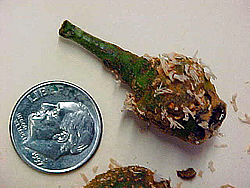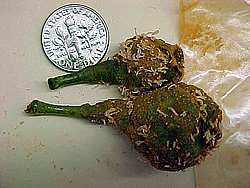| Question:
My name is Lee Dudley CEA Ag & NR in Limestone County.
A home owner brought an immature Asian pear to my office
to identify the fungus on the fruit; I could use your expertise.
I have taken digital pictures and attached them. Not seen
in the pictures is an orange dust developed by the fungus
which is covering the tree, but it seems the spores are
limited only to the fruit.
Answer: This is most probably Japanese
pear rust ( I say probably
because there are a couple of other rusts that occur with
much less frequency). The symptoms are the result of infection
by the rust fungus Gymnosporangium asiaticum. What you are
seeing are aecia (rust fruiting structures where aeciospores
are produced)---the aecia are somewhat tubulat and elongated
and white in color...but are filled with orange-brown spores
(aeciospores) that are released when the aecia rupture...which
is clearly happening in the images that you included.
This rust has 2 hosts--the pear and Juniper spp--its alterbate
host --probably J. procumbens oor J. chinensis. Spores from
the pear infect the juniper which produces 2 additional
and different spore stages, one spore stage of which then
re-infects the pear, probably in mid spring in your area.
Infection in the pear can occur to both the fruit and to
the
leaves. Even though symptoms can be significant, control
is rarely
warranted.
Spraying the pear with triadimefon (Strike or Bayleton--or
Eagle/Spectrcide Immunox)in early spring may help...but
some years the disease is prevelant and other years, non-existant.
Larry W. Barnes
Professor and Extension Plant Pathologist
Texas Plant Disease Diagnostic Laboratory
Texas A&M University
College Station, TX 77845
PH 979-845-8032
FAX 979-845-6499
=========================================
ANSWER FROM JIM KAMAS IN FREDERICKSBURG:
Either as you suggest or perhaps quince rust, which we
saw in the Lightsey orchard about nine years ago. Absolutely
devastates varieties such as 'Kieffer'. Other hybrids like
'Orient" and 'Ayres' were untouched. The SI fungicides
did take care of the problem. Bayleton is no longer on the
market I believe, but Nova is and is labeled for pears.
I suggest a 4 oz per acre rate as perscribed for powdery
mildew. Elice had great success. This kind of spring is
ideal for all of the rusts.
|






